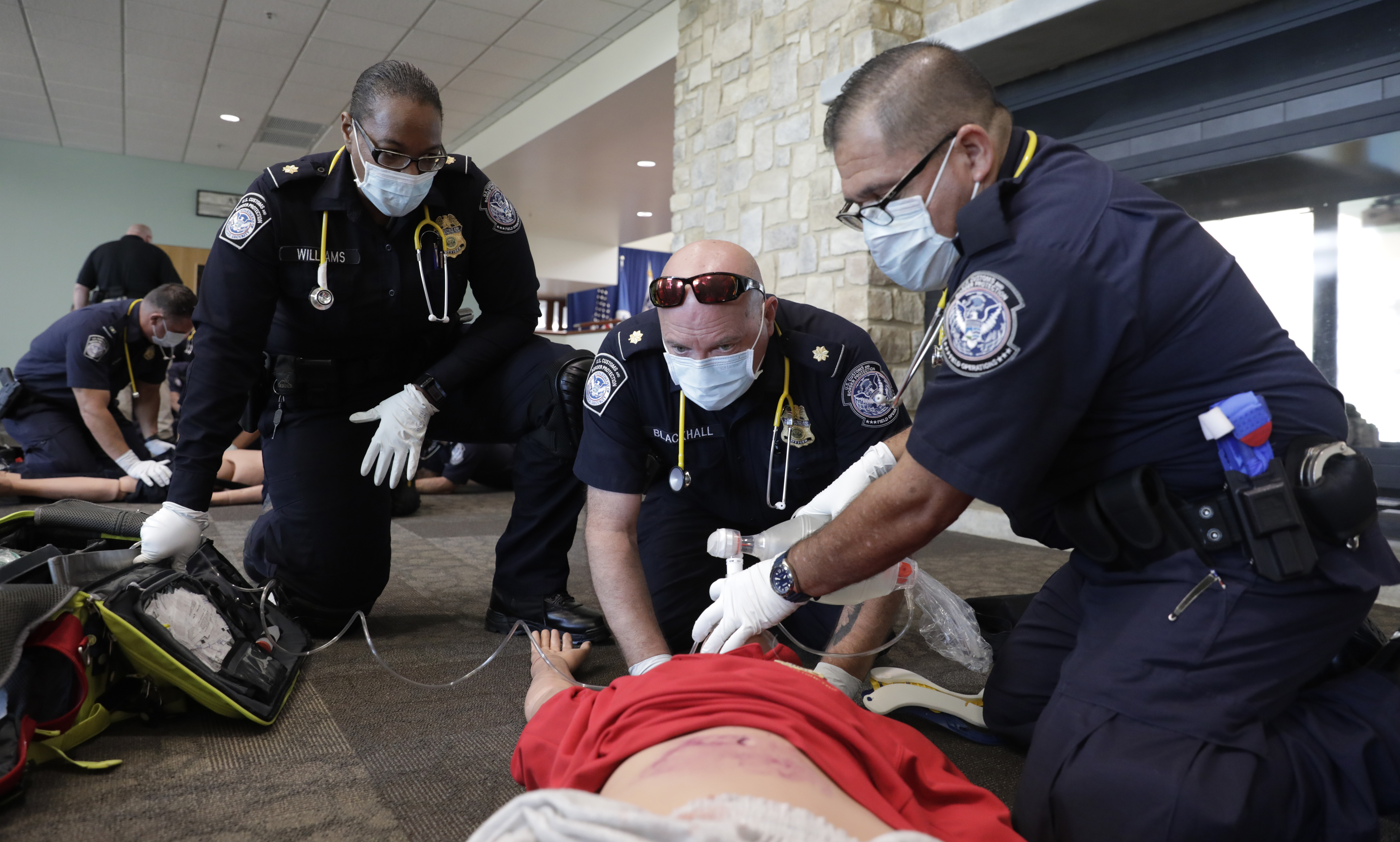
The Miracle Workers
CBP emergency medical technician students perform a class exercise using a bag valve mask to resuscitate a simulated patient. The course is part of a new agency initiative designed to train and certify CBP personnel as emergency medical technicians to help the traveling public. Photo by Glenn Fawcett
In mid-March, as the coronavirus was taking hold and families across America were hunkering down, a group of U.S. Customs and Border Protection officers with medical expertise were called to action. At the time, most of the officers were in Harper’s Ferry, West Virginia, starting to teach an eight-week emergency medical technician course, designed to train and certify CBP personnel in the field. The course was part of a new initiative, which requires the agency to train 100 individuals as emergency medical technicians from its field operations’ workforce each year. “CBP sees an average of a million travelers a day, and a lot of those travelers experience medical emergencies. We have to be able to assist them,” said Geoff Smith, who oversees the Office of Field Operations’ newly formed Operational Medicine Branch.
But by the first week of class, the virus outbreak was so severe, a national emergency was declared, and the students, who had travelled from ports throughout the U.S. and Canada, were sent home. The instructors were also from ports throughout the country, but their help was still needed. Smith reached out them.
“I told the instructors, ‘By all means you can go home and be with your families. It’s completely understandable. But right now, our coordination cell at headquarters, which coordinates the activities and guidance we’re giving to the field for the COVID-19 pandemic, is hurting for people and we definitely need some assistance working in that cell,’” said Smith. “We wanted them to use their skill sets, not just as CBP officers, but also as emergency medical technicians who have experience managing a crisis. They’re trained to deal with these situations.”
The response was unanimous. “There wasn’t one of the instructors that said, ‘No,’” said Smith. “They all stepped up to the plate immediately and asked, ‘What do you need us to do?’”
In total, there were four instructors from the March class who volunteered to stay—Ken Hoepelman, the lead instructor, from John F. Kennedy International Airport in Queens, New York; Jeremy Mattison, from the port of Pembina in North Dakota; Jackie Ramsey, stationed at the agency’s Field Operations Academy in Glynco, Georgia; and Hristijan Kontrin, from the San Luis Port of Entry in Arizona.
A fifth officer, William Bundy, at Hartsfield-Jackson Atlanta International Airport, was also tapped. Bundy had been the star pupil of CBP’s first emergency medical technician class, taught in 2019. “He was the class leader and left a great impression on the instructors,” said Smith.
Two other officers, both based in New York State, Santana Coon from the port of Buffalo, and Joni Jarus from the port of Champlain, also offered their services. Both had taught previous sessions of the course. Coon had been asked to teach the March class, but had other commitments. After the virus hit, her plans changed and she reached out to Hoepelman to see if she could help. “I texted Ken, and within minutes, he texted me back, ‘How soon can you get here?’ I drove out the next week,” said Coon. Jarus, who arrived in Washington, D.C., at the end of April, was enrolled in a firefighter class that was cancelled. After Hoepelman found out, he asked if she could help too.
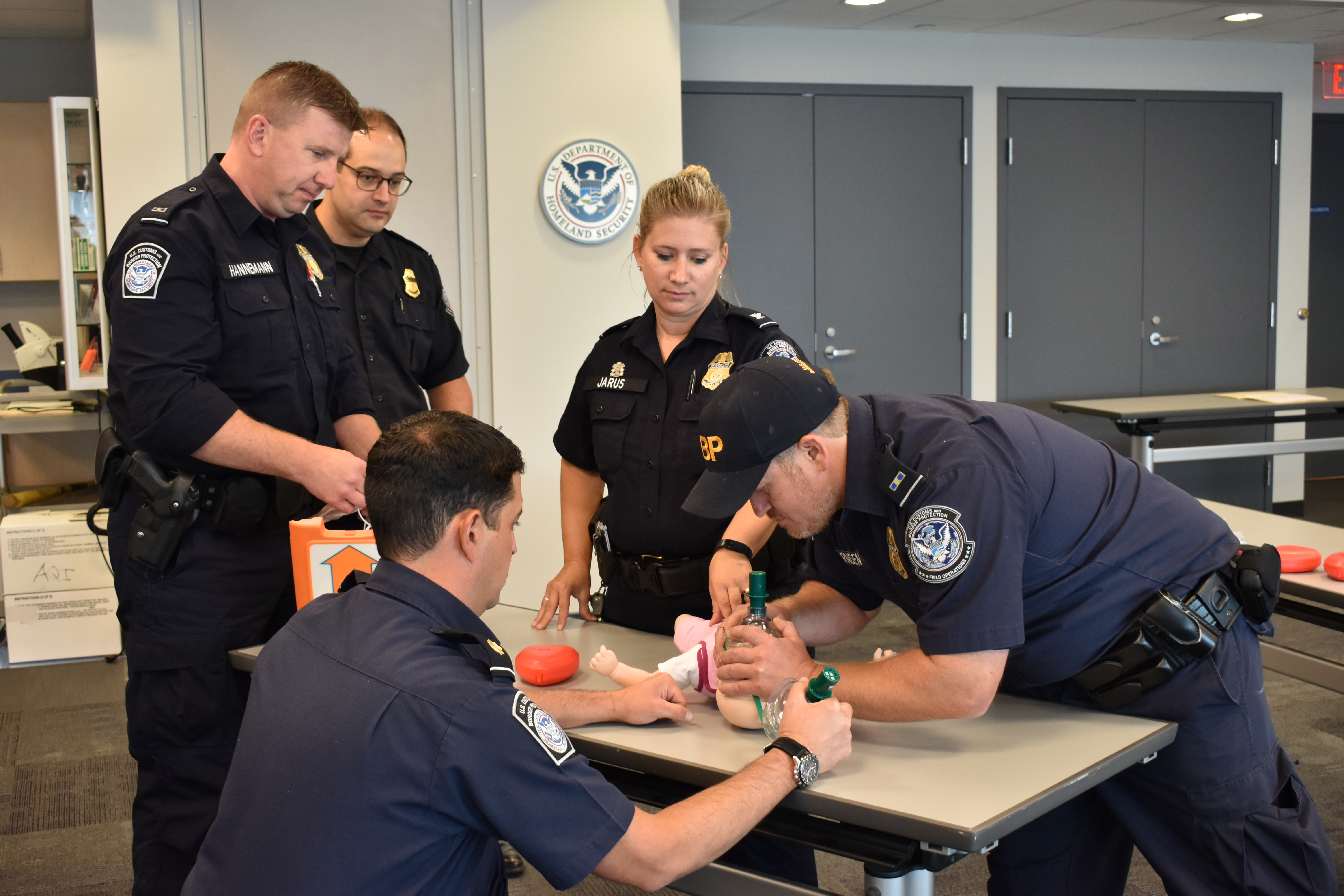
CBP Watch Commander Joni Jarus at the port of Champlain, center, was one of the emergency medical technician instructors who volunteered to help the agency at headquarters during the pandemic. Above, Jarus observes students at the port of Champlain after teaching them how to perform cardiopulmonary resuscitation on infants. Students, clockwise from upper left, Eric Hanneman, Stephan Fischl, Nicholas Harnden, and Shane Needle. Photo by Melissa Harnden
Although their personal situations varied, the officers’ reasons for volunteering were pretty much the same. “I am very sensitive to people asking for help. If there is a need that can be met, I try to do that,” said Bundy, who, at age 40, has spent his entire adult life in public service. “I knew that CBP’s response to the coronavirus was going to be an important endeavor. To have a chance to be part of that, was a very attractive thought.”
Meeting the challenge
Working in the Coronavirus Coordination Cell was challenging. The responsibilities were weighty. “The ports were calling from across the country, trying to find out what to do if they encountered someone who was sick or potentially COVID positive,” said Hoepelman, the team lead on the night shift. “Our main concern was ensuring that we protect our officers, the traveling public, and anyone else who was coming in contact with people who were unresponsive, sick, or needed medical attention. At the time, we didn’t know who was COVID positive and who wasn’t. Coronavirus was everywhere. So it was critical that we knew how to mitigate the spread of the disease.”
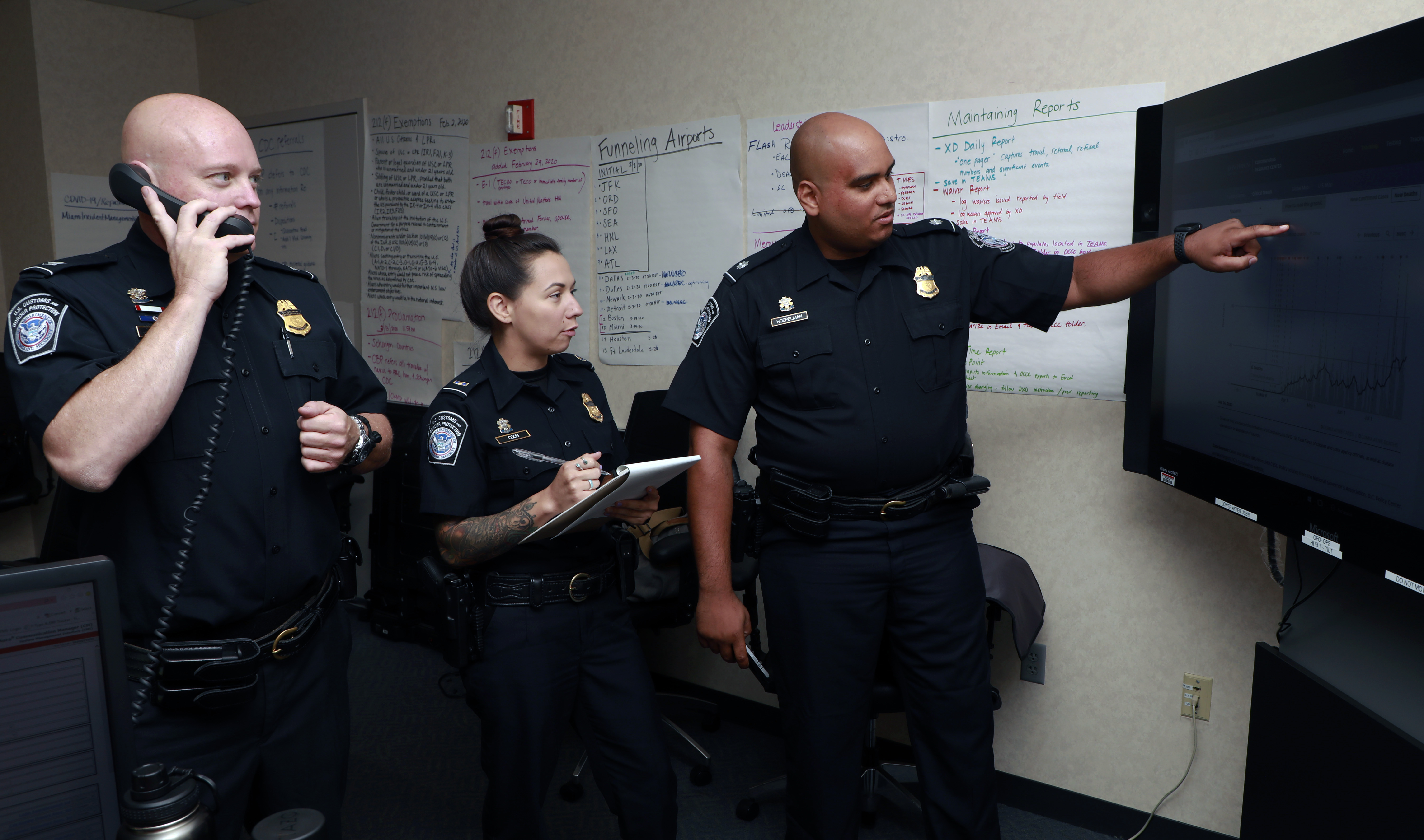
Working in CBP’s Coronavirus Coordination Cell, from left, Geoff Smith, Santana Coon, and Ken Hoepelman look at worldwide COVID-19 infection rates to track the spread of the disease. Photo by Jaime Rodriguez Sr.
Repatriation was another major concern. The officers helped screen flights and coordinate ways to bring home thousands of U.S. citizens and permanent legal residents who were traveling or living abroad. Many feared they were going to be stranded overseas. “Most countries shut their airspace down pretty heavily during the pandemic. It became hard to get anywhere via plane because we didn’t know how the virus was spreading,” said Bundy. “Domestic air travel almost ended during this time and international travel was the same.”
The repatriated flights took many hours to coordinate and required a lot of liaising with other agencies and the airlines. On average, the officers would track 10 flights a day. “We would get a list of 300 people and 280 of them would be Americans without current U.S. passports. We worked with the State Department and CBP’s National Targeting Center to figure out how to ensure these people were actually American citizens,” said Bundy. “Some had retired in a foreign country and their passports had expired. Some were children of American citizens and had never lived in the U.S. or pursued getting a U.S. passport. So we had to apply immigration law to determine whether they were actually American citizens.”
In some cases, Bundy explained, passengers were citizens of Canada, Mexico, or other countries, and their flights were transiting through the U.S. “We had to liaise with the embassies of those countries to ensure that when these flights arrived, the travelers were repatriated directly to their countries,” he said.
Added to this were time zone challenges. “We worked with the State Department all over the world. Often our time differences were 12 to 14 hours apart, and we were trying to communicate all of this information using different sets of government lingo because we all speak a different dialect of shorthand and acronyms,” said Bundy.
Furthermore, there wasn’t a preexisting set of standard operating procedures. “There wasn’t a process for these repatriated flights. We built it from the ground up while we were in the middle of it,” said Bundy, who relied on his experience from the field as the morning immigration supervisor at Atlanta Airport to guide him.
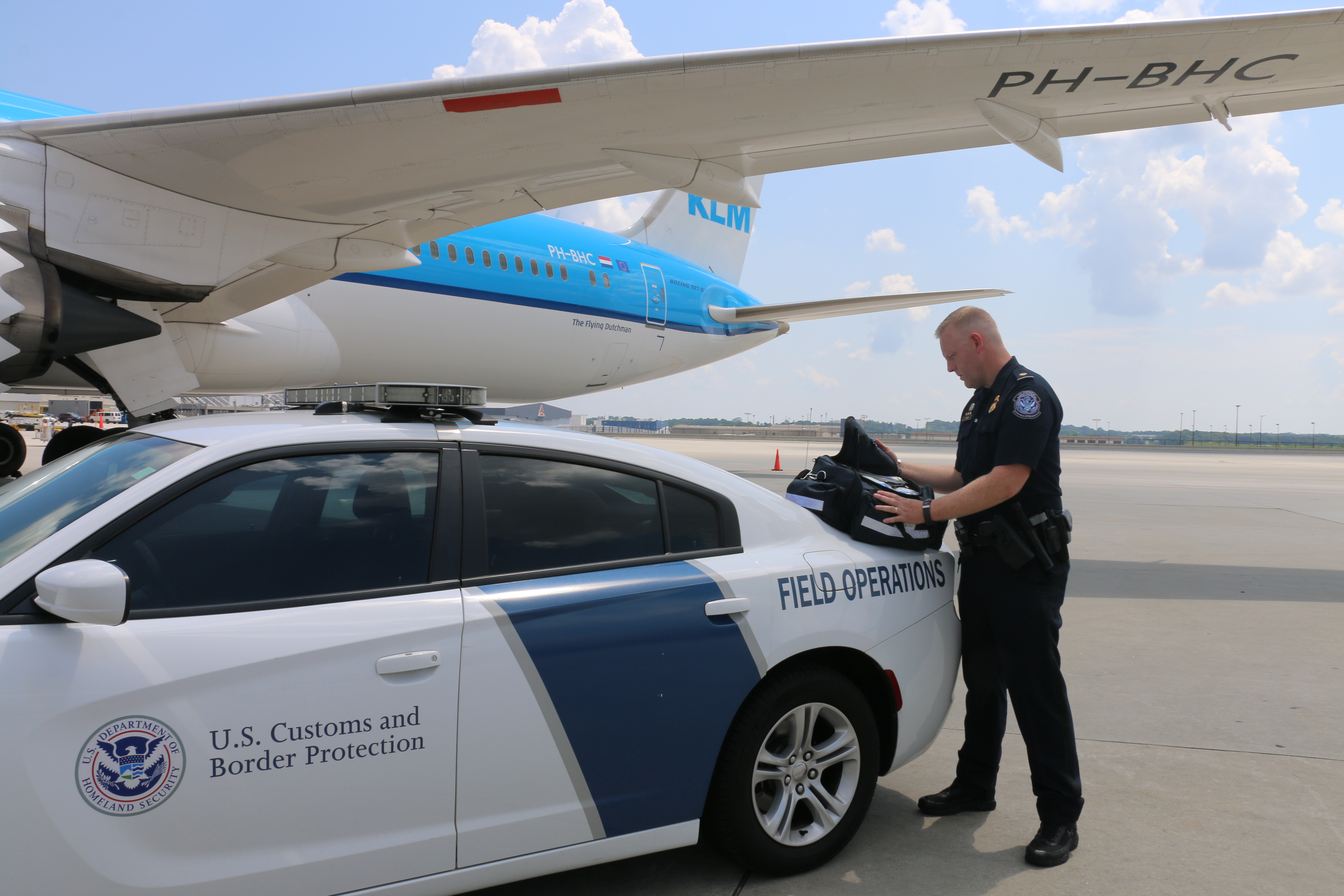
Supervisory CBP Officer William Bundy, one of the emergency medical technicians who volunteered to help the agency during the coronavirus pandemic, checks his medical kit to prepare to help a passenger needing medical assistance on an incoming flight at Hartsfield-Jackson Atlanta International Airport. Photo by Robert Brisley
The Coronavirus Coordination Cell received a lot of questions from the field on cruise ships too. “Most countries were shut down to cruise ships. They simply would not allow them to dock. They refused to let people come ashore, and the cruise ships turned into hot beds for the virus,” said Bundy. “So we worked very closely with the Centers for Disease Control and Prevention and the U.S. Coast Guard to develop a process for countries to take people off ships and get them back to their home countries.”
One of the cruise ships Bundy assisted was floating off the coast of Peru. “It took 15 days to get approval to disembark the passengers and arrange for their travel home,” said Bundy, noting that two of the passengers had emerging medical issues. “The State Department had to attest that the passengers on the cruise ship would not be allowed into the general population. They were not going to be permitted to enter Peru and disappear,” he explained. “The State Department arranged for the transport and we coordinated the different places the private plane would land. We also coordinated medical assistance on the aircraft. There was a travel nurse on board. The plane flew from Peru to the U.S., and then to Canada, making stops to drop off the passengers with medical needs.”
Multiple responsibilities
Operationally, the cell was in a constant state of flux. “Things changed every day. We had to react to different scenarios,” said Coon. “Someone would say, ‘Hey, we need to start tracking this,’ or ‘we need to collect this data,’ or ‘implement this new guidance because the rules just changed.’”
The cell was flooded with emails, hundreds over the course of a day, and the phone didn’t stop ringing. “The emails and phone calls were coming in constantly with questions from the field,” said Bundy. “We were yelling back and forth across the room. ‘Who is dealing with the Dulles issues? Who is handling the repatriation flight? Who is talking with chief counsel?’ It never stopped,” said Bundy. “At the other end of that email or phone call was a real person in the field with live bodies standing in front of him or her. So we were working at a high pace as fast as we could to make sure that all of those people who were asking questions were getting responses to help them do their jobs.”
The Coronavirus Coordination Cell also worked closely with CBP’s Emergency Operations Center, the agency’s hub for responding to COVID-related requests for information and actions. If the requests had anything to do with CBP’s field operations, they were funneled to the cell. “We would reach out to the various field offices, try to collate their responses, and push them back up to the Emergency Operations Center,” said Bundy.
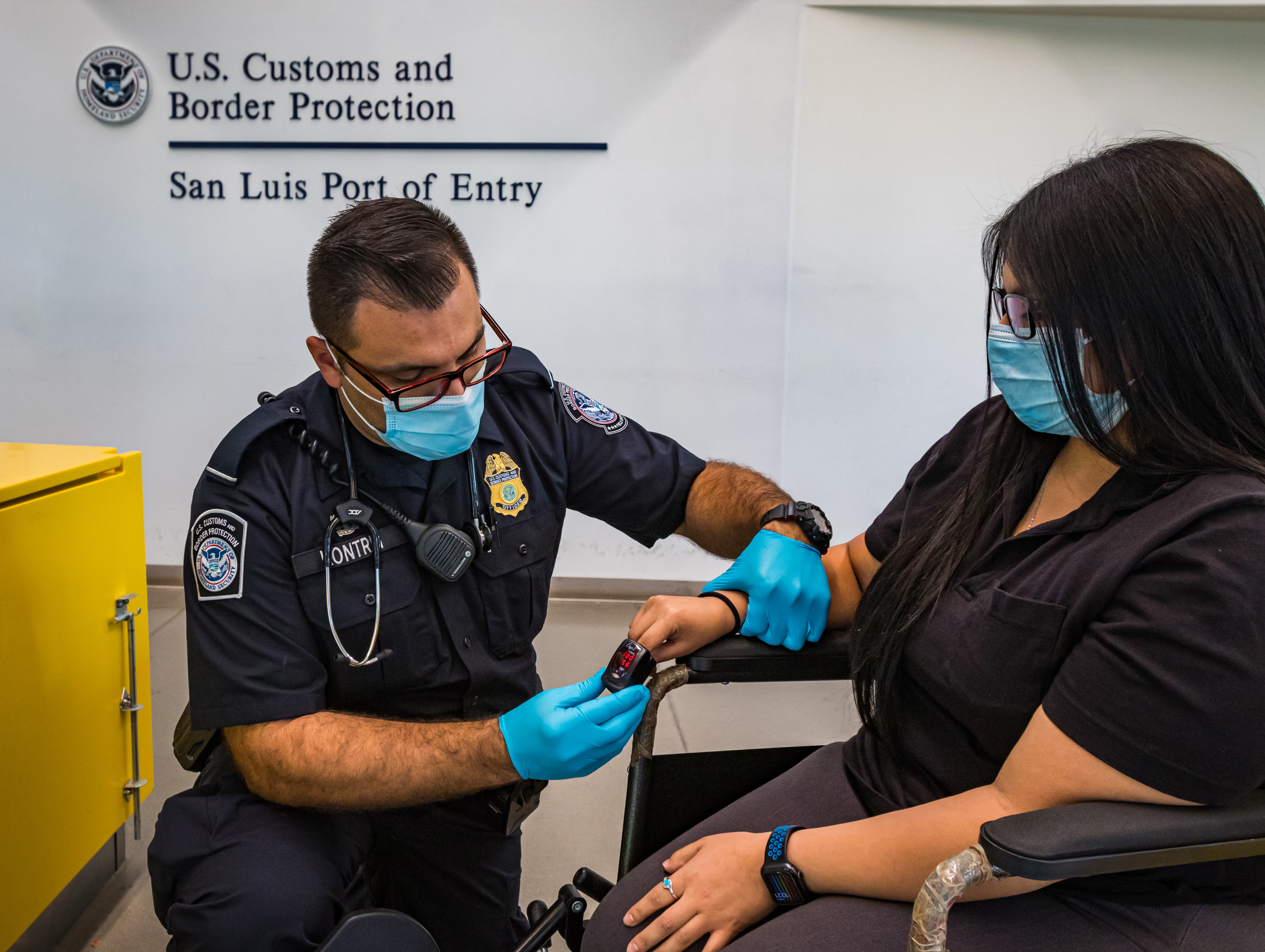
At the San Luis Port of Entry in Arizona, CBP Officer Hristijan Kontrin checks a patient’s pulse while measuring the oxygen level in her blood. Kontrin, one of the emergency medical technician instructors who volunteered to help during the pandemic, was assigned to work in CBP’s Emergency Operations Center where he assisted the agency’s medical team. Photo by John A. Schwamm
One of the instructors, Hristijan Kontrin, was assigned to work in the Emergency Operations Center with CBP’s medical team. Kontrin and the team assisted CBP’s senior medical advisor with developing the agency’s COVID-19 risk exposure guidance. “As employees were exposed to the virus, management could refer to the guidance to determine the level of exposure and what they needed to do,” said Kontrin, who would then follow-up with the employees. “I wanted to reach out personally and find out how they were exposed to the disease and reassure them that someone was here for them. I would ask how they were doing, what symptoms they had, how long they were going to be out of work, and if they needed anything. When I was at headquarters, we had over 1,000 cases,” he said.
“Most had a dry cough and fever. Some were really ill. We also had deaths that happened. It was shocking,” said Kontrin. “Line of duty deaths happen all the time, but it’s usually for other reasons. You would never expect this to be the cause.”
Kontrin tried to comfort the employees. “We listened to them and heard their frustrations. We assured them that we were listening, that we were working to do better to help them out,” he said.
From the information the medical team gathered, changes were made to help protect employees. “We discovered that some of the officers were putting on a mask or gloves after they realized a traveler was symptomatic. By then, it’s too late. The officer is already exposed,” said Kontrin. “We needed to prevent that from happening. That’s one of the reasons we went from guidance that said, ‘Personal protective equipment is available. You can put a mask on if you want,’ to the policy we have now that says, ‘it’s mandatory to wear a mask to help protect you and your coworkers.’”
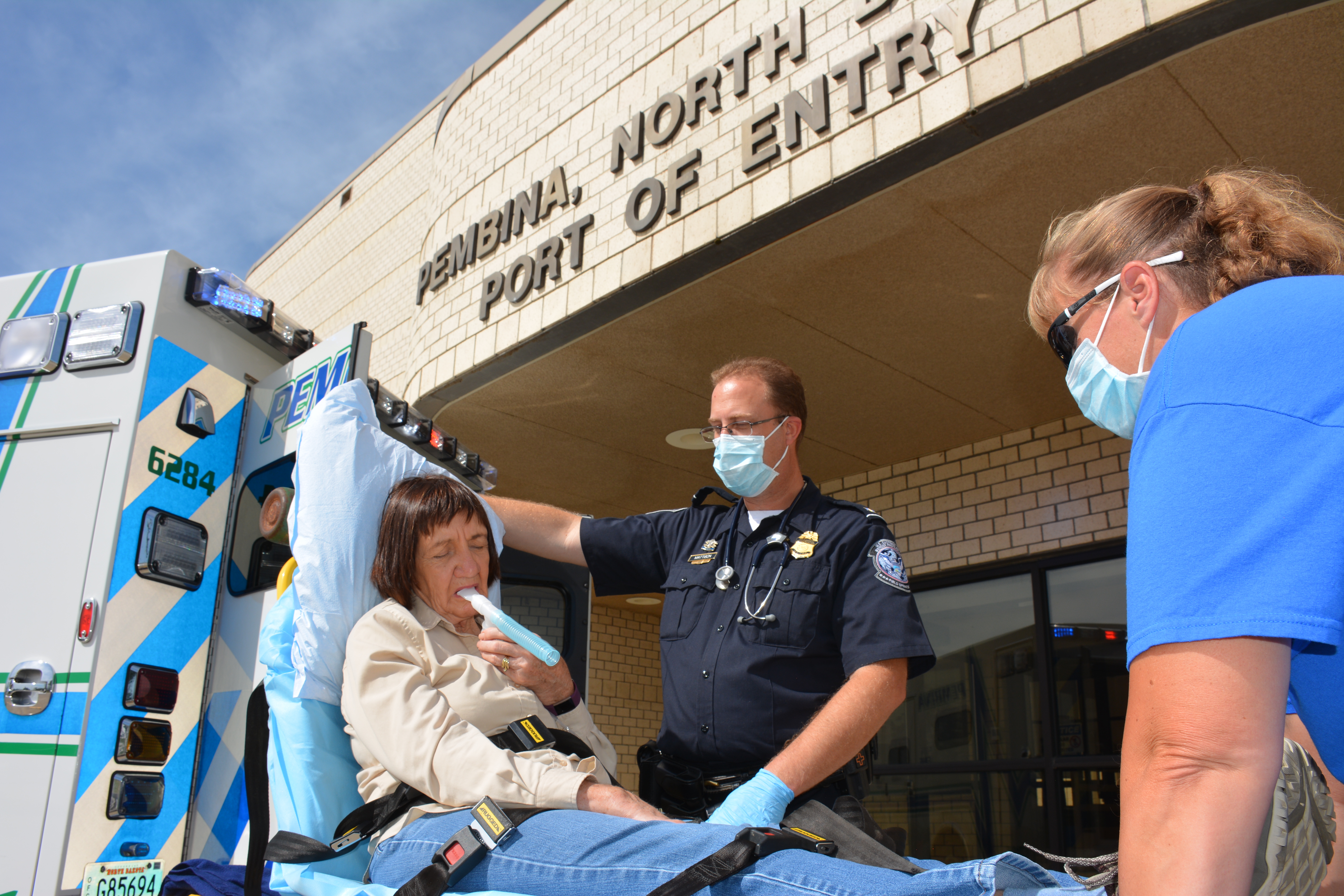
CBP Officer Jeremy Mattison, center, one of the emergency medical technician instructors who volunteered to remain at CBP headquarters to help the agency during the COVID-19 pandemic, assists a patient who is having difficulty breathing at the port of Pembina in North Dakota. Photo by Eric Nilson
Forward thinking
Collectively, the officers tried to be proactive. They looked at best practices such as how to treat COVID-positive individuals who were unresponsive; how to maintain social distancing; and how to don, doff, and discard personal protective equipment. They also researched, procured, and sent more advanced medical equipment to the field. “Instead of waiting for someone to get infected, we wanted to be proactive and get ahead of it,” said Hoepelman, who drew from his experiences at JFK Airport and as an emergency medical technician at the New York City Fire Department. “I was a frontline officer at JFK when the Ebola outbreak was ramping up, so I understood how communicable diseases spread.” Hoepelman also understood how a lack of appropriate equipment can leave frontline workers open to exposures. “I wanted to make sure that our employees were protected,” he said.
Hoepelman and Smith designed a curriculum to train emergency medical technicians on the Southwest border where the influx of travelers into the U.S. remained high. “As more people were infected and the spread of the disease grew wider, we knew that the probability of our officers responding to someone who is COVID positive was increasing,” said Hoepelman.
Six officers including Coon were sent to field locations along the U.S.-Mexico border. “We went to the ports to see how their operations were affected, to find out how we could help them and what resources and training we could provide,” said Coon. “There had been a lot of emergency medical incidents at the ports of entry, especially in San Diego, where officers had to perform CPR on recently deceased people who had tested positive for COVID. We were able to show the officers ways to administer CPR that gave them more protection.”
Coon also addressed preparedness issues. “We wanted the officers to think about contingency plans. Right now, the ports are seeing an increased number of coronavirus incidents, but generally only one or two people are showing up at the same time,” said Coon. “We wanted the officers to be ready to handle situations like the migrant caravans, where 200 people arrived at the port and overwhelmed the system.”
Strong dedication
At 27, Coon was the youngest instructor who volunteered. Traveling cross-country during the pandemic was a risk to her own health, but she took it in stride. “When we take this job, we all volunteer to be that person who will be there and doesn’t run away from things,” she said. “Being an emergency medical technician taught me to be that one person who is stable and isn’t scared during situations where people are panicked. We have to be the calm through the storm.”
Throughout their commitment to helping their colleagues, the agency, and the country at large, the officers endured hardships. “On average, we worked 10 hour days. I worked 45 days straight with one day off,” said Bundy, who only saw his family for one week during the three months he volunteered. “It was hard being apart. My wife was doing my job, her job, and the teacher’s job because the kids were not in school.”
Hoepelman’s wife and children, ages 6 and 8, lived in New York City, the coronavirus epicenter. “There are three hospitals in the area where I live. Many of them were receiving a lot of COVID patients or were doing testing, so the potential for my family to be at risk was very high,” said Hoepelman. “My kids would cry for me every night. ‘Why is daddy not here? When will daddy be home?’ That would kill me, which is why every other weekend I would drive four hours to get home, stay for a day, and then drive back on Sunday to be able to report to work early Monday morning. I never felt like I had a day off.”
But the experience was gratifying. “This is a once in a lifetime opportunity. We haven’t dealt with a pandemic on this level in my lifetime,” said Bundy. “There’s definitely a sense of fulfillment. When you get a phone call at two o’clock in the morning from a supervisor at a small border port and he doesn’t know how to deal with the person crossing the border who says that he has COVID and appears to be sick, to be able to take that phone call is very fulfilling.”
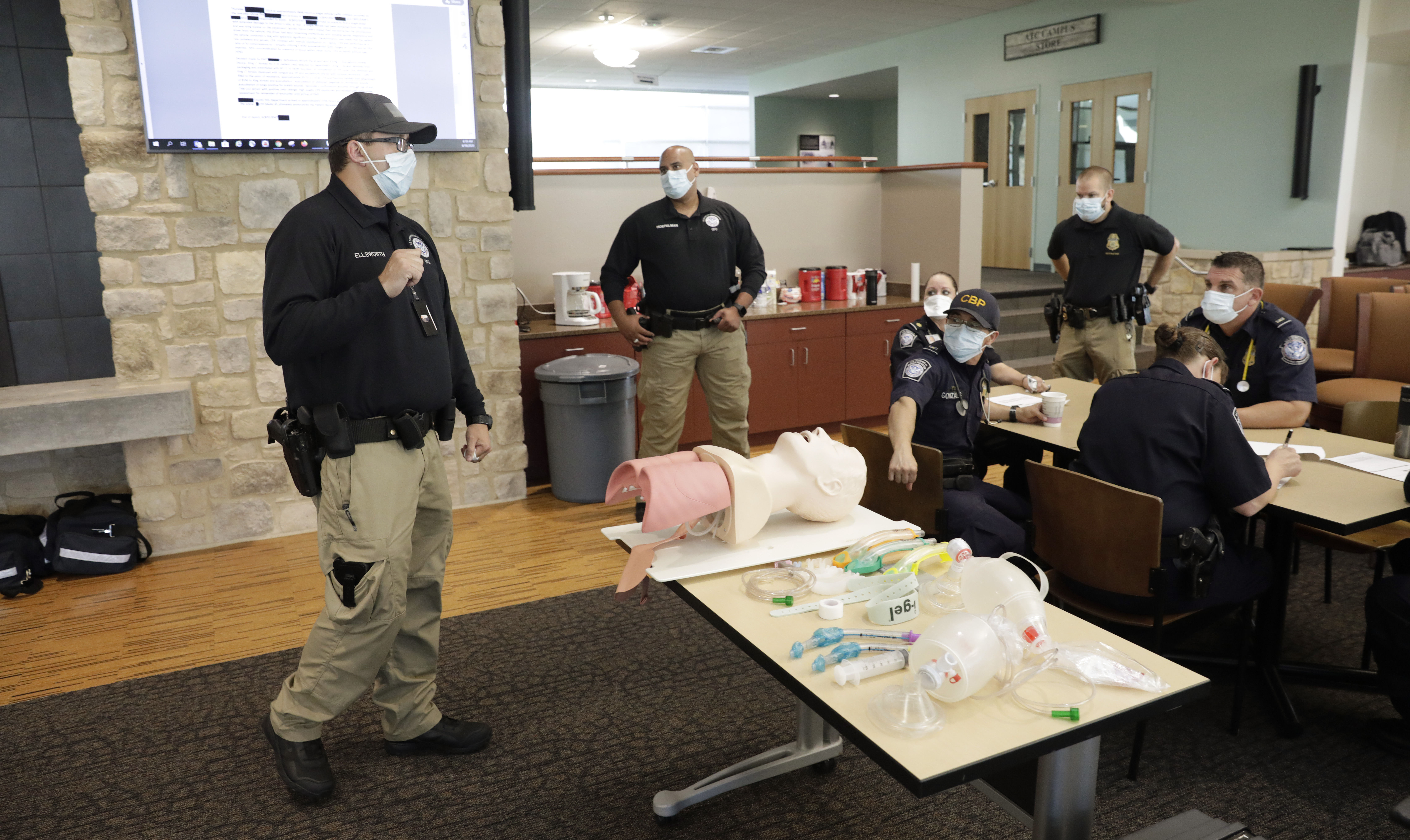
After the coronavirus outbreak in mid-March forced CBP’s emergency medical technician course to end early and students were sent home, instructors volunteered to stay at headquarters to help during the pandemic. Above, lead instructors CBP Watch Commander Benjamin Ellsworth, left, and CBP Officer Ken Hoepelman, center, resume course instruction in July, teaching the returning students in Harper’s Ferry, West Virginia. Photo by Glenn Fawcett


